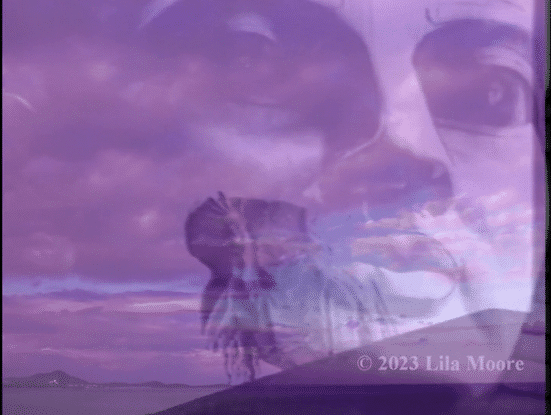The Nous Of Communitas- Networked Workshop
The participants' feedback:
The sessions you facilitated were extremely enriching, both as a group and individually. The journey from the response to violence - working as various channels responding to each other's work - to compassion, was simply beautiful.

This remote session was considered as a highly creative altered state of consciousness that generates the emergence of novel forms and ideas. It explored communitas which represents a radical departure from the conventions of fixed identity and social hierarchy and an encounter with a unifying nous of cosmic dimension.
The online interaction utilized cyberspace as a non-local space-time onto which a digital field of influence, an intended dimension in space-time, was added by the participants. In this context, the field is regarded as an immaterial nous (mind/consciousness) conceptualized in the form of a digital broadcast which can be traced on a digital file and re-activated. The purpose of the field, which the participants generate, is two-fold: 1. To investigate the dynamics of violence and compassion. 2. To activate a compassionate and procreative ‘morphic resonance in the field.’ (See: The Presence of the Past: Morphic Resonance and the Habits of Nature by Rupert Sheldrake). Compassion is regarded as a coherent state of consciousness that when experienced with others produce a field of consciousness with presence in the world. According to the Global Consciousness Project, cooperative intention based on compassion has consequences.
Generating a field of communitas, which is a compassionate state of oneness, provided an opportunity for the participants to embed their projects and visions in a collective field of influence fuelled by a powerful emotion and intentional technology. This field of compassionate nous was also articulated in broader terms as a prototype morphic field of compassion designed to counteract the dominant narrative of violence.
The participants collaborated on a 4-part ritualistic process that induced the stages leading to communitas, involving the experience of auto-communication and allo-communication. The process integrated the principles of the ritualistic form in art as theorized by Maya Deren (1946) and ritual behavior as put forward by Roy Ascott in Behaviourist Art and the Cybernetic Vision.
Firstly, the ritualistic process commenced in a video room, which functioned as an 'initiation pod.' It involved an introspection process through which each participant shed her known identity and transformed into a channel of communication which was allocated for her by a remote, initiating cyborg-entity, on the basis of her responses to the situation and to its questions.
Secondly, the participants' task was to start designing and generating the field through the input and feedback of their appointed five channels. They were divided into The Sound Channel (SC), The Vision Channel (VC), The Scribe/Text Channel (TC), The Movement Channel (MC) and The Intention Channel (IC). Each participant was limited to one channel, hence, to a sole mode of perception and expression. The Intention Channel (IC) was the mediator between the channels and allied with the universal Nous and the archetype of the shaman. It coordinated the progression of the channels' communication and work on the field. This part involved working in teams and creative explorations of the dynamics of violence and compassion through a set of responses and their correlated feedbacks.
The five channels are the basic structure and form at the core of the CFI's model and are designed for learning and creative processes as well as for rites. They are an intricate formal body supported by research and can be utilized in diverse manners and in conjunction with various apps and technologies. (This is further explained in Dr Moore's post-doc thesis. The topic of the channels will also be further elaborated in an upcoming conference).
The third part was described by one of the participants as 'chaotic' though 'intense,' and as such, it reflected the liminal phase of communitas, which is an in between, and often a disorientating, state before emerging and becoming a novel form, being or idea. It provided the psychic fuel and the sense of 'being deeply connected,' which was reported by the participants, and needed for the final part.
Fourthly, the channels weaved a field of digital images, texts and sounds out of their initial responses whilst broadcasting it online through an interactive and remote networked and intentional procedure. Following the tradition of religious or spiritual ritual practice, the live broadcast was not meant to be a public performance but a secret ceremony for participants only, dedicated to the invocation of a noetic field and resonance. The digital files of the broadcast which have remained with the participants are the prototypes of the initial field generated by the unified team consciousness, which is diverse, syncretic but coherent. As such, they may resonate with one another and others and perhaps attract similar systems in space-time regardless of location or point in time.
Overall, the session offered an auspicious environment for the cultivation of the participants’ germinal ideas and projects by developing their capacity to work in teams, exchange and evolve together subtle and highly creative ideas, and extend the boundaries of the possible through the comprehension of the yet unharnessed potential and power of compassion, which is the gift of communitas.
The participants' feedback:
It was messy and chaotic in moments, but the rest of the workshop was very intense and has left each one of us feeling deeply connected.


Photos © Agnieszka Pokrywka
Partiipants: Tia Vellani, Lei Han, Neha chaturvedi, Angeliki Diakrousi, Farhana Tani, Ivana Pinna
Offline/online technical support: Agnieszka Pokrywka
Online technical assistant: Yigal Eran
The Nous of Communitas is based on an original learning and creating method and a body of writings and creative practice which were developed by Dr Lila Moore as an Advanced Research Associate of Planetary Collegium of Plymouth University. The Workshop was part of BecomeBecome Masterclass, Athens, 2016











